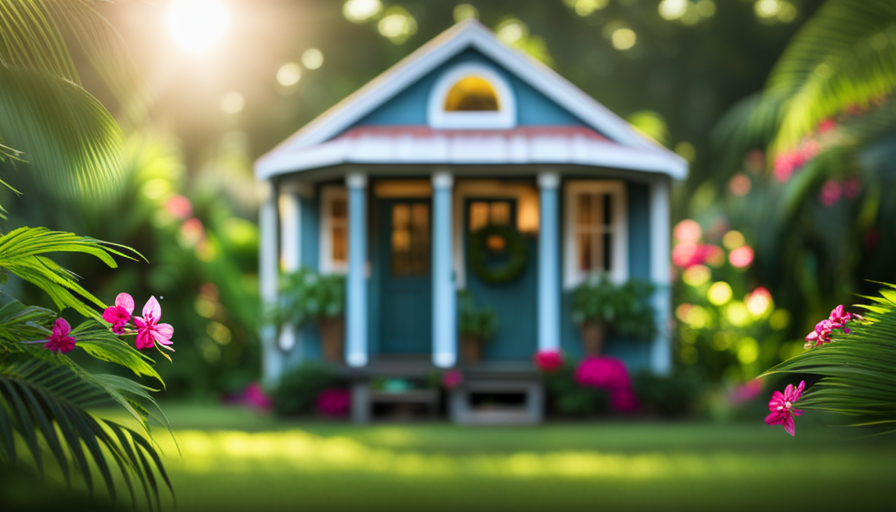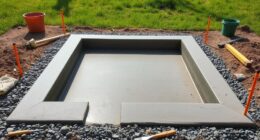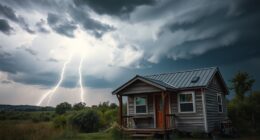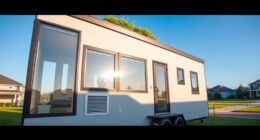Have you ever imagined living in a cozy, minimalistic space where simplicity blends with freedom? Well, you’re not alone. The growing fascination with tiny homes has captured the imaginations of many people, myself included.
However, before embarking on this unique lifestyle in the sunshine state, it’s crucial to understand the ins and outs of where you can legally place your tiny abode. Florida, known for its diverse landscapes and vibrant communities, offers various options for tiny house enthusiasts.
In this article, I will guide you through the intricacies of zoning laws, tiny house-friendly communities, RV parks, private land options, and co-living communities. I will also provide insights into joining tiny house associations and networks, as well as the potential of building your own custom tiny house.
Additionally, we will discuss budgeting for utilities and maintenance costs, ensuring that your tiny house experience in Florida is as seamless and enjoyable as possible.
So, let’s dive into the world of tiny house living in the Sunshine State!
Key Takeaways
- Understanding zoning laws and regulations is crucial when considering where to place a tiny house in Florida.
- Consider alternative options such as RV parks, campgrounds, or private land for more flexibility and freedom.
- Co-living communities in Florida may allow tiny houses and offer a supportive environment for tiny house enthusiasts.
- Connect with local authorities, join tiny house associations, and attend workshops to gain knowledge and find suitable locations for your tiny house.
Know the Zoning Laws and Regulations
Before you start looking for a place to put your tiny house in Florida, it’s important to familiarize yourself with the zoning laws and regulations. Tiny house zoning laws vary from one city to another, so it’s crucial to understand what is allowed and what is not.
In some areas, there may be restrictions on the size of the tiny house, its foundation type, or even the number of occupants. It’s essential to do thorough research and reach out to local authorities to ensure you comply with all the regulations.
Fortunately, there are several tiny house-friendly communities in Florida that have embraced the concept and made it easier for people to live in these compact dwellings. These communities typically have specific areas designated for tiny houses, with zoning laws tailored to accommodate them. They understand the benefits of tiny houses, such as affordability, sustainability, and minimal environmental impact.
When looking for a place to put your tiny house in Florida, consider searching for these tiny house-friendly communities. They can provide you with the necessary information and resources to make your dream of living in a tiny house a reality.
In the next section, we’ll explore how to find these communities and what to look for when considering them as potential locations for your tiny house.
Look for Tiny House-Friendly Communities
When searching for tiny house-friendly communities in Florida, it’s important to consider specific zoning laws and regulations. These communities are designed to accommodate tiny houses and often have legal requirements in place to ensure the safety and sustainability of the community.
Here are some key points to keep in mind when looking for tiny house communities in Florida:
-
Size restrictions: Many tiny house communities have specific size requirements for the houses, usually ranging from 100 to 400 square feet. It’s important to check the community’s regulations to ensure your tiny house meets these guidelines.
-
Utilities and infrastructure: Tiny house communities often provide access to utilities such as water, electricity, and sewage systems. Make sure to inquire about these amenities and any associated costs.
-
Community rules and regulations: Each tiny house community may have its own set of rules and regulations that residents must abide by. These can include restrictions on noise levels, pet ownership, and exterior appearances. Familiarize yourself with these rules before committing to a community.
By considering these factors, you can find a tiny house community in Florida that meets your needs and complies with legal requirements. Once you have explored the options available, it’s time to consider other alternatives such as RV parks and campgrounds to park your tiny house and enjoy the Florida lifestyle.
Explore RV Parks and Campgrounds
When exploring RV parks and campgrounds as potential places to put a tiny house in Florida, it’s important to check for long-term stay options and amenities.
Some parks and campgrounds offer extended stays and even have designated areas for tiny houses.
It’s also crucial to research the park or campground policies on tiny houses, as not all places may allow them or have specific rules and regulations in place.
By considering these factors, you can find a suitable location to park your tiny house in Florida.
Check for Long-Term Stay Options and Amenities
While exploring the possibilities for placing a tiny house in Florida, envision the tranquil bliss of waking up to the warm coastal breeze and picturesque views at a long-term stay option with all the desired amenities.
Here are three factors to consider when looking for a long-term stay option for your tiny house in Florida:
-
Budgeting: Look for options that fit within your budget, considering factors such as monthly rates, utilities, and any additional fees.
-
Long-term sustainability: Choose a place that offers sustainability features like renewable energy sources, water conservation initiatives, and recycling programs.
-
Amenities: Consider the amenities that are important to you, such as laundry facilities, recreational areas, proximity to attractions, and access to community events.
Researching park or campground policies on tiny houses is the next step in finding the perfect location for your tiny house in Florida.
Research Park or Campground Policies on Tiny Houses
Explore the policies of parks and campgrounds to ensure your dream of living in a tiny house becomes a reality in the Sunshine State.
When it comes to tiny house building regulations, different parks and campgrounds may have varying rules and restrictions. Some may have specific guidelines for the size, design, and construction of tiny houses, while others may require them to be certified by certain organizations.
Additionally, it’s crucial to inquire about tiny house parking options. Some parks and campgrounds may offer designated areas or spaces for tiny houses, while others may not allow them at all.
By researching these policies, you can find the right park or campground that aligns with your vision of living in a tiny house in Florida.
Considering private land options, let’s explore other possibilities for placing your tiny house in the state.
Consider Private Land Options
If you’re searching for the perfect spot to place your tiny house in Florida, you should definitely consider the various options of private land available. Private land offers several benefits for tiny house owners. Firstly, you have more freedom and flexibility in terms of design and placement. Unlike public spaces or campgrounds, private land allows you to customize your tiny house according to your preferences and needs. Additionally, private land often has fewer zoning requirements compared to other types of properties, making it easier to legally place your tiny house.
To help you understand the advantages of private land options in Florida, here is a table outlining some key factors to consider:
| Factor | Private Land Option 1 | Private Land Option 2 | Private Land Option 3 |
|---|---|---|---|
| Location | Rural | Suburban | Coastal |
| Size of Property | 1 acre | 0.5 acre | 2 acres |
| Utilities | Water, electricity | Water, electricity | Water, electricity |
| Zoning Requirements | Minimal | Moderate | Minimal |
As you can see, private land options provide a range of locations and sizes to suit your preferences. Additionally, the zoning requirements are generally more lenient, allowing for a smoother process when placing your tiny house.
Considering these benefits, it is worth investigating co-living or co-housing communities in Florida. These communities often have shared resources and amenities, which can enhance your tiny house living experience.
Investigate Co-Living or Co-Housing Communities
When looking for options on where to put my tiny house in Florida, I discovered the concept of co-living or co-housing communities. These communities are designed to foster a sense of community and shared responsibilities among residents.
One key benefit of co-living communities is that they often allow tiny houses, providing a solution for those looking to live in a smaller space. By understanding the shared responsibilities and benefits of these communities, I can make an informed decision about whether co-living is the right choice for me and my tiny house in Florida.
Find Co-Living Communities that Allow Tiny Houses
Look for co-living communities in Florida where you can park your tiny house and become part of a like-minded community. Finding tiny house friendly neighborhoods can be a challenge, but there are several co-living communities in Florida that allow tiny houses. These communities offer a unique and supportive environment for tiny house enthusiasts.
In these communities, you can find a sense of belonging and camaraderie with others who share your passion for tiny living. Living in a co-living community allows you to have access to shared resources and amenities, such as communal gardens, common areas, and even workshops where you can learn new skills and share your knowledge with others.
Exploring tiny house communities in Florida can open up a world of opportunities for you to connect with like-minded individuals and make lasting friendships. By joining a co-living community, you can enjoy the benefits of community living while still maintaining the independence and privacy that comes with living in a tiny house. Understanding the shared responsibilities and benefits of living in these communities is essential to ensuring a harmonious and fulfilling experience.
Understand the Shared Responsibilities and Benefits
Embrace the sense of community and discover the countless shared responsibilities and benefits that come with living in a co-living community in Florida.
In tiny house communities, residents share various responsibilities, from maintaining common areas to participating in decision-making processes. This shared responsibility fosters a strong sense of belonging and encourages collaboration among neighbors.
Moreover, living in a co-living community provides numerous benefits. It allows for a more sustainable lifestyle, as residents can share resources and reduce their environmental impact. Additionally, it offers a chance to build meaningful connections with like-minded individuals who share similar values and interests.
By living in a tiny house community, you can enjoy the support and camaraderie of your neighbors while creating a unique and fulfilling living experience.
To explore this option further, consult with local authorities or planning departments to ensure compliance with regulations and find suitable locations for your tiny house.
Consult with Local Authorities or Planning Departments
To gain insight into the placement options for your tiny house in Florida, you should consult with local authorities or planning departments. Consulting with these entities offers several benefits.
Firstly, you can gain a better understanding of the local zoning regulations and any restrictions that may apply to tiny houses in your desired area. This knowledge is crucial to ensure that you’re in compliance with the law and can avoid any potential legal issues in the future.
Secondly, planning department recommendations can provide valuable guidance on suitable locations for your tiny house, taking into consideration factors such as infrastructure, utilities, and community amenities. By seeking their expertise, you can make an informed decision about where to place your tiny house in Florida, ensuring a more seamless integration into the surrounding community.
Lastly, consulting with planning departments also allows you to establish a positive relationship with local authorities, which can be beneficial when navigating the process of obtaining permits or addressing any concerns that may arise. By working together, you can ensure a smoother experience throughout the placement process.
In addition to consulting with local authorities, it’s also advisable to join tiny house associations or networks.
Join Tiny House Associations or Networks
When it comes to exploring the world of tiny houses in Florida, connecting with other enthusiasts is key. By joining tiny house associations or networks, I’ve been able to tap into a wealth of knowledge and experience from like-minded individuals.
Attending workshops and events has provided me with the opportunity to learn directly from experienced tiny house owners, gaining valuable insights and tips on everything from design and construction to sustainable living practices.
These connections and educational experiences have been instrumental in my own journey towards living in a tiny house in Florida.
Connect with Other Tiny House Enthusiasts in Florida
Connect with other tiny house enthusiasts in Florida by joining local meetups, attending workshops, and participating in online forums, where you can share your passion and gain valuable insights from like-minded individuals. By connecting with others who share your interest in tiny houses, you can find a supportive community that can provide guidance and inspiration as you navigate the process of owning and living in a tiny house in Florida.
To help you visualize the possibilities, here is a table that highlights some of the ways you can connect with other tiny house enthusiasts in Florida:
| Meetup Groups | Workshop Events | Online Forums |
|---|---|---|
| Tiny House Florida | Tiny House Workshops Florida | Tiny House Florida Facebook Group |
| Tampa Bay Tiny Homes | Tiny House Festivals Florida | Tiny House Forum |
By attending workshops or events to learn from experienced tiny house owners, you can further expand your knowledge and gather valuable tips and tricks for successfully living in a tiny house in Florida.
Attend Workshops or Events to Learn from Experienced Tiny House Owners
After connecting with other tiny house enthusiasts in Florida, I was inspired to delve deeper into the world of tiny houses. One of the best ways to learn about tiny house building techniques and design ideas is by attending workshops or events hosted by experienced tiny house owners.
These gatherings provide a fantastic opportunity to gain hands-on knowledge and learn from those who have already gone through the process of building and living in a tiny house. At these workshops or events, you can participate in practical demonstrations, ask questions, and network with like-minded individuals. It’s an excellent way to expand your knowledge and get inspired for your own tiny house journey.
So, let’s explore how you can consider DIY or custom-built tiny houses and continue on this exciting path of tiny house exploration.
Consider DIY or Custom-Built Tiny Houses
You can easily find the perfect location to place your tiny house in Florida if you opt for a DIY or custom-built option. Building your own tiny house or having one custom-made allows you the freedom to choose the size, design, and features that best suit your needs and preferences. With a DIY tiny house, you have the opportunity to showcase your creativity and create a unique space that reflects your personality.
Custom-built tiny houses, on the other hand, offer the convenience of having professionals handle the construction process while ensuring that your specific requirements are met.
When considering a DIY or custom-built tiny house, it’s important to take into account the regulations and zoning laws in Florida. Different counties and cities may have specific requirements for tiny houses, such as minimum square footage or specific building codes. It’s crucial to research and comply with these regulations to avoid any legal issues.
Once you have your DIY or custom-built tiny house ready, you can start exploring various locations in Florida to place it. Whether you prefer a rural area surrounded by nature or a more urban setting, the Sunshine State offers a diverse range of options. From private land rentals to tiny house communities, there are plenty of opportunities to find a spot that suits your lifestyle and preferences.
As you plan for the placement of your tiny house, it’s essential to also consider your budget for utilities and maintenance costs. By carefully managing your resources and choosing energy-efficient systems, you can minimize the expenses associated with utilities and maintenance. This will allow you to fully enjoy the benefits of living in a tiny house in Florida while keeping your costs under control.
Budget for Utilities and Maintenance Costs
Minimize monetary mishaps by managing your monthly maintenance and utility expenses effectively in order to maximize your tiny abode adventure in the Sunshine State.
When it comes to budgeting for utilities and maintenance costs, here are four key factors to consider:
-
Energy Efficiency: Invest in energy-efficient appliances and insulation to lower your electricity bill. Consider solar panels to harness the abundant Florida sunshine and reduce your reliance on the grid.
-
Water Conservation: Install low-flow fixtures and consider collecting rainwater for non-potable uses. Efficient water usage not only helps the environment but also saves you money on your water bill.
-
Insurance Coverage: Protect your tiny house investment by securing comprehensive insurance coverage. Research different insurance providers to find the most affordable option that suits your needs.
-
Finding Affordable Tiny House Builders or Contractors: When building or renovating your tiny house, look for builders or contractors who specialize in small spaces. They can provide cost-effective solutions and help you stay within your budget.
By carefully managing your expenses and considering these factors, you can enjoy the benefits of tiny house living while keeping your finances in check. Embrace the tiny house lifestyle in Florida and discover the freedom and simplicity it offers.
Embrace the Tiny House Lifestyle in Florida
Living in a tiny house in Florida has been an incredible experience for me. I’ve fully embraced the benefits of this lifestyle, from the financial freedom it offers to the minimalistic mindset it encourages.
The Sunshine State is the perfect location to enjoy the beauty of nature and explore the countless attractions available. Whether it’s relaxing on the beaches, hiking in the Everglades, or visiting the vibrant cities, there’s always something exciting to do in Florida.
Enjoy the Benefits of Living in a Tiny House in the Sunshine State
Experience the perks of residing in a tiny house while basking in the warm and sunny atmosphere of the Sunshine State, Florida. If you’re looking to embrace the tiny house lifestyle here, you’ll be pleased to know that Florida offers a variety of options for tiny house communities.
These communities provide a supportive and like-minded community where you can connect with others who share your passion for minimalist living. Additionally, Florida has relatively lenient regulations when it comes to tiny houses, making it easier to find a suitable location for your tiny home. From allowing tiny houses on wheels to providing opportunities for permanent placement, the state welcomes tiny house enthusiasts with open arms.
With the tiny house community and regulations in place, you can enjoy the benefits of living in a tiny house in Florida. Now, let’s explore the natural beauty and attractions of Florida.
Explore the Natural Beauty and Attractions of Florida
With its stunning beaches, lush wildlife reserves, and vibrant cities, the Sunshine State offers a plethora of natural beauty and attractions to explore.
Florida is not just about the famous tourist destinations; it’s also home to some hidden gems that are worth discovering.
From the Everglades National Park, where you can experience the unique ecosystem of marshes and swamps, to the crystal clear springs of Central Florida, perfect for swimming and snorkeling, there is no shortage of outdoor activities to enjoy.
Explore the charming coastal towns along the Gulf Coast, where you can indulge in fresh seafood and soak up the laid-back atmosphere.
Don’t forget to visit the Florida Keys, a tropical paradise known for its stunning coral reefs and vibrant marine life.
Whether you’re a nature lover or an adventure seeker, Florida has something for everyone.
Frequently Asked Questions
Can I legally live in a tiny house on wheels in Florida?
Yes, you can legally live in a tiny house on wheels in Florida, but it’s subject to certain regulations. Tiny house zoning regulations vary by county and city, so it’s crucial to research and comply with the specific requirements in your desired location.
Additionally, Florida has several tiny house communities that offer legal and supportive environments for tiny house living. These communities provide amenities, like shared spaces and utilities, making them a popular choice for tiny house enthusiasts in Florida.
Are there any restrictions on the size or design of a tiny house in Florida?
There are restrictions on the size and design of a tiny house in Florida. The zoning regulations and building codes determine the requirements for tiny houses. These regulations ensure that the structures meet safety standards and are suitable for habitation. It’s important to consult with local authorities and research the specific zoning regulations and building codes in the area where you plan to build or place your tiny house.
What are the requirements for connecting utilities to a tiny house in Florida?
Connecting utilities to a tiny house in Florida is governed by regulations set by local authorities. These requirements ensure the safe and efficient provision of essential services. Before connecting utilities, it’s crucial to comply with all regulations regarding water, electricity, and sewer connections. Local building codes and zoning regulations must be followed to ensure proper installation and adherence to safety standards. Consulting with local utility providers and authorities will provide specific guidelines for connecting utilities to your tiny house.
Are there any specific areas in Florida that are known for being more welcoming to tiny houses?
Tiny house communities in Florida are becoming increasingly popular, providing a welcoming environment for tiny house enthusiasts. While there aren’t any specific areas known for being more welcoming to tiny houses in Florida, it’s worth noting that some states have already implemented regulations to accommodate tiny houses. By studying these regulations in other states, Florida can develop a framework that allows for the creation of designated areas for tiny houses. This would ensure that tiny house owners have legal options for placing their homes in Florida.
Can I park my tiny house on a friend or family member’s property in Florida without any legal issues?
You may be able to park your tiny house on a friend or family member’s property in Florida without any legal issues, but it’s important to be aware of the tiny house parking regulations and zoning laws in your specific area.
These regulations and laws vary between counties and cities in Florida, so it’s essential to research and understand the rules that apply to your location. It’s recommended to consult with local authorities or seek legal advice to ensure compliance with the relevant regulations.
Conclusion
In conclusion, finding a place to put a tiny house in Florida requires careful research and consideration of various options. From understanding zoning laws to exploring tiny house-friendly communities and private land options, there are several avenues to explore.
One interesting statistic to note is that Florida has over 1,000 RV parks and campgrounds, making it a viable option for those looking to live in a tiny house on wheels.
By embracing the tiny house lifestyle, individuals can enjoy the unique benefits and freedom that comes with living in a smaller space.
Hi, I’m Emma. I’m the Editor in Chief of Tiny House 43, a blog all about tiny houses. While tree houses are often associated with childhood, they can be the perfect adult retreat. They offer a cozy space to relax and unwind, surrounded by nature. And since they’re typically built on stilts or raised platforms, they offer stunning views that traditional homes simply can’t match. If you’re looking for a unique and romantic getaway, a tree house tiny house might just be the perfect option.










